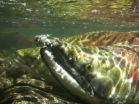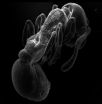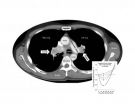(Press-News.org) About one-third of American infants and children who suffer bleeding into brain tissue, may later have seizures and as many as 13 percent will develop epilepsy within two years, according to new research reported at the American Stroke Association's International Stroke Conference 2013.
Bleeding into brain tissue is a type of stroke called intracerebral hemorrhage (ICH). Each year, an estimated 6.4 newborns and children per every 100,000 in the United States suffer strokes. About half of the strokes are hemorrhagic, typically caused by rupturing of weakened or malformed blood vessels.
In the largest study of its kind, researchers tracked 73 subjects including 53 children, ranging in age from one month to 18 years, and 20 newborns, who experienced ICH between 2007 and 2012 at three hospitals.
Visible seizures occurring more than a week after the ICH were classified as remote symptomatic seizures. Such longer-term seizures suggest epilepsy might be developing, said Lauren A. Beslow, M.D., M.S.C.E., lead study author and now an instructor of pediatrics and neurology at Yale University in New Haven, Conn.
Among the study's findings:
About 60 percent of the newborns and 43 percent of the older children had visible seizures at the time of the stroke or within a week after.
Of 32 patients who had continuous electroencephalographic monitoring, 28 percent had seizures that otherwise would have gone undetected. The researchers plan to explore whether these subtle seizures are a risk factor for more seizures, epilepsy or other problems over the long-term.
About 13 percent of all study subjects developed epilepsy within two years.
Patients who had elevated pressure in the brain that required medical or surgical treatment were more likely to have later seizures and epilepsy.
"Information on the risk for later seizures and epilepsy provides practitioners with concrete numbers that can be presented to families," Beslow said. "While an estimate of 13 percent may seem low at two years, the rate of epilepsy might be greater at later time points."
A key strength of the study is that data was collected in real time, rather than after the fact. But with just 73 patients and few that had remote seizures or developed epilepsy, the team could not explore all potential risk factors for the development of epilepsy.
Factors that make newborns vulnerable to ICH are not well understood, but include fetal distress, sepsis, blood conditions, exposure to blood thinners, and congenital heart disease. For older children, malformed blood vessels, blood disorders, or exposure to blood thinners can also play a role in developing ICH.
###
The research was led by Lori C. Jordan, M.D., Ph.D., at Vanderbilt University in Nashville, Tenn.; Rebecca N. Ichord, M.D., at The Children's Hospital of Philadelphia; and Beslow who was a fellow and then an instructor at The Children's Hospital of Philadelphia when the study was conducted. Patients were from those two institutions and Johns Hopkins University in Baltimore.
Other co-authors are Nicholas S. Abend, M.D.; Melissa C. Gindville, B.S., M.S.; Rachel A. Bastian, B.A.; Daniel J. Licht, M.D. and Sabrina E. Smith, M.D., Ph.D. Author disclosures are on the abstract.
The National Institutes of Health and the L. Morton Morley Funds of the Philadelphia Foundation funded this research.
Follow news from the ASA International Stroke Conference 2013 via Twitter @HeartNews; #ISC13.
Learn more from the American Stroke Association about stroke in children.
Statements and conclusions of study authors that are presented at American Stroke Association scientific meetings are solely those of the study authors and do not necessarily reflect association policy or position. The association makes no representation or warranty as to their accuracy or reliability. The association receives funding primarily from individuals; foundations and corporations (including pharmaceutical, device manufacturers and other companies) also make donations and fund specific association programs and events. The association has strict policies to prevent these relationships from influencing the science content. Revenues from pharmaceutical and device corporations are available at www.heart.org/corporatefunding.
Note: Actual presentation of this moderated poster is 4:25 p.m. HT, Thursday, Feb. 7, 2013.
All downloadable video/audio interviews, B-roll, animation and images related to this news release are located on the right column of the release link. Video clips with researchers/authors of studies will be added to the release links after embargo.
Infant, child stroke survivors prone to seizures, epilepsy
Abstract: TMP 99
2013-02-07
ELSE PRESS RELEASES FROM THIS DATE:
Some stroke patients whose life support is withdrawn may have achieved a less-than-ideal
2013-02-07
More than a third of patients who suffer a major bleeding in the brain and have their life support withdrawn might have eventually regained an acceptable level of functioning if life support had been sustained, suggests a new study presented at the American Stroke Association's International Stroke Conference 2013.
In the United States, 10 percent of the estimated 795,000 strokes each year are intracerebral hemorrhages (ICH). ICH is the most common type of bleeding stroke and it occurs when a weakened blood vessel inside the brain ruptures and leaks blood into surrounding ...
Magnetic map guides salmon home
2013-02-07
For sockeye salmon coming home after years spent at sea, a magnetic map is apparently responsible for their remarkable sense of direction. That's according to an analysis of data collected over 56 years and reported online on February 7 in Current Biology, a Cell Press publication.
"To find their way back home across thousands of kilometers of ocean, salmon imprint on the magnetic field that exists where they first enter the sea as juveniles," said Nathan Putman of Oregon State University. "Upon reaching maturity, they seek the coastal location with the same magnetic ...
For ant pupae, status means being heard
2013-02-07
AUDIO:
This is a recording of ant pupa sound.
Click here for more information.
For young ants at the pupal stage of life—caught between larva and adulthood—status is all about being heard. The findings, reported online on February 7 in Current Biology, a Cell Press publication, add to evidence that ants can communicate abstract information through sound in addition to chemical cues.
"One of the truly fascinating characteristics of social insects is their power of self-organization, ...
Researchers identify potential target for age-related cognitive decline
2013-02-07
As the elderly age, their ability to concentrate, reason, and recall facts tends to decline in part because their brains generate fewer new neurons than they did when they were younger. Now, researchers reporting in the February 7th issue of the Cell Press journal Cell Stem Cell have discovered a molecule that accumulates with age and inhibits the formation of new neurons. The finding might help scientists design therapies to prevent age-related cognitive decline.
The investigators identified the molecule, called Dickkopf-1 or Dkk1, in the brains of aged mice. By blocking ...
Reassuring evidence: Anticancer drug does not accelerate tumor growth after treatment ends
2013-02-07
Studies in animals have raised concerns that tumors may grow faster after the anticancer drug sunitinib is discontinued. But oncologists and physicists who collaborated to analyze data from the largest study of patients with kidney cancer convincingly demonstrate that such tumor acceleration does not occur in humans. The findings, publishing online on February 7th in the Cell Press journal Cell Reports, suggest that sunitinib does not cause lingering risks for patients after their treatment ends.
"We were able to demonstrate that this applied across all patients and that ...
Hopkins researchers uncover key to antidepressant response
2013-02-07
Through a series of investigations in mice and humans, Johns Hopkins researchers have identified a protein that appears to be the target of both antidepressant drugs and electroconvulsive therapy. Results of their experiments explain how these therapies likely work to relieve depression by stimulating stem cells in the brain to grow and mature. In addition, the researchers say, these experiments raise the possibility of predicting individual people's response to depression therapy, and fine-tuning treatment accordingly. Reports on separate aspects of the research were published ...
Treatment with clot-busting drug yields better results after stroke than supportive therapy alone
2013-02-07
In an update to previous research, Johns Hopkins neurologists say minimally invasive delivery of the drug tPA directly into potentially lethal blood clots in the brain helped more patients function independently a year after suffering an intracerebral hemorrhage (ICH), a deadly and debilitating form of stroke. Rates of functional recovery with the active tPA treatment far surpassed those achieved with standard "supportive" therapy that essentially gives clots a chance to shrink on their own.
In the current Johns Hopkins-led study, ICH patients who randomly received the ...
Clot-retrieval devices failed to improve stroke-related disability
2013-02-07
A stroke survivor's chances of living independently after 90 days are not improved by the use of devices inserted into the artery to dissolve or remove a stroke-causing clot shortly after the onset of symptoms, according to a randomized controlled trial involving 656 patients.
The study, funded by the National Institute of Neurological Disorders and Stroke (NINDS), part of the National Institutes of Health, compared the intra-arterial device-based approach plus the current standard of intravenous (IV) tissue plasminogen activator (t-PA), a clot-busting drug with IV t-PA ...
In the brain, broken down 'motors' cause anxiety
2013-02-07
VIDEO:
This video (S3 in the paper) shows the transport defect of the serotonin receptor in a KIF13A knock out neuron compared with a wild type neuron.
Click here for more information.
When motors break down, getting where you want to go becomes a struggle. Problems arise in much the same way for critical brain receptors when the molecular motors they depend on fail to operate. Now, researchers reporting in Cell Reports, a Cell Press publication, on February 7, have shown ...
Salmon may use magnetic field as a navigational aid
2013-02-07
CORVALLIS, Ore. – The mystery of how salmon navigate across thousands of miles of open ocean to locate their river of origin before journeying upstream to spawn has intrigued biologists for decades, and now a new study may offer a clue to the fishes' homing strategy.
In the study, scientists examined 56 years of fisheries data documenting the return of sockeye salmon to the Fraser River in British Columbia – and the route they chose around Vancouver Island showed a correlation with changes in the intensity of the geomagnetic field.
Results of the study, which was supported ...
LAST 30 PRESS RELEASES:
An ‘illuminating’ design sheds light on cholesterol
Who is more likely to get long COVID?
Study showcases resilience and rapid growth of “living rocks”
Naval Research Lab diver earns Office of Naval Research 2025 Sailor of the Year
New Mayo-led study establishes practical definition for rapidly progressive dementia
Fossil fuel industry’s “climate false solutions” reinforce its power and aggravate environmental injustice
Researchers reveal bias in a widely used measure of algorithm performance
Alcohol causes cancer. A study from IOCB Prague confirms damage to DNA and shows how cells defend against it
Hidden viruses in wastewater treatment may shape public health risks, study finds
Unlock the power of nature: how biomass can transform climate mitigation
Biochar reshapes hidden soil microbes that capture carbon dioxide in farmland
Reducing saturated fat intake shows mortality benefit, but only in high-risk individuals
Manta rays create mobile ecosystems, study finds
Study: Mixed results in using lipoic acid to treat progressive multiple sclerosis
Norbert Holtkamp appointed director of Fermi National Accelerator Laboratory
New agentic AI platform accelerates advanced optics design
Biologists discover neurons use physical signals — not electricity — to stabilize communication
Researchers discover that a hormone can access the brain by hitchhiking
University of Oklahoma researcher awarded funding to pursue AI-powered material design
Exploring how the visual system recovers following injury
Support for parents with infants at pediatric check-ups leads to better reading and math skills in elementary school
Kids’ behavioral health is a growing share of family health costs
Day & night: Cancer disrupts the brain’s natural rhythm
COVID-19 vaccination significantly reduces risk to pregnant women and baby
The role of vaccination in maternal and perinatal outcomes associated with COVID-19 in pregnancy
Mayo Clinic smartwatch system helps parents shorten and defuse children's severe tantrums early
Behavioral health spending spikes to 40% of all children’s health expenditures, nearly doubling in a decade
Digital cognitive behavioral treatment for generalized anxiety disorder
Expenditures for pediatric behavioral health care over time and estimated family financial burden
Air conditioning in nursing homes and mortality during extreme heat
[Press-News.org] Infant, child stroke survivors prone to seizures, epilepsyAbstract: TMP 99



